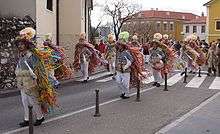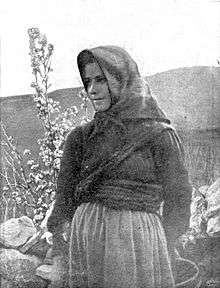Istro-Romanians
 Carnivals Zvončari from Žejane, 2006 | |
| Total population | |
|---|---|
| 76 | |
| Languages | |
|
Istro-Romanian; also Croatian, Italian | |
| Religion | |
| Roman Catholic | |
| Related ethnic groups | |
| Vlachs, Morlachs, Aromanians, Romanians |
Istro-Romanians / Istrorumeni (ethnonym: Rumeni and occasionally also Rumâri and Rumêri), also called Ćiribirci, Ćići, and Vlahi by the local population, and Istro-Romanians by linguists, are a small ethnic group living in small area of northeastern Istria, in the village Žejane in eastern plateau of mountain Ćićarija, and several villages in a region of former Lake Čepić west of Mt. Učka.
The 2001 Croatian census lists only 48 Romanian language speakers in Istria county.[1] In the 2011 Croatian census, Istria listed 49 Romanians and 6 Vlachs.[2]
The inhabitants of villages and hamlets speak the Čakavian dialect which it is believed originated in Dalmatia. However, there is no known record to show that the Istro-Romanians came from Dalmatia. That there are traces of Istro-Romanian words in the Cakavian Istrian vocabulary and vice versa indicate only that over the centuries the two neighboring linguistically different groups assimilated through daily social contact and intermarriages, as happens with other peoples and their languages throughout the world.
History
The first historical record of Romanians in the Istrian region purportedly dates back to 940 A.D. when scholarly Roman Emperor Constantine VII recorded in De Administrando Imperio" that there were Latin-language speakers in this area who called themselves Romans but who did not come from Rome. A later historical record of Romanians in Istria (not necessarily the "Ćići", and possibly the "Morlacchi" i.e. Vlachs) dates back to 1329, when Serbian chronicles mention that a Vlach population was living in the area, although there was an earlier mention from the 12th century of a leader in Istria called Radul which may have been a Romanian name.
In his monumental book, Historia antica, e moderna sacra, e profana, della città di Trieste, published in his native town of Trieste in 1698, Fra Ireneo della Croce (1625–1713) wrote:
"Un'altra memoria antica, degna d'osservatione non minore della già addotte Antichità Romane, osservo in alcuni Popoli addimandati comunemente Chichi habitanti nelle Ville d'Opchiena, Tribichiano, e Gropada situate nel Territorio di Trieste, sopra il Monte cinque miglia distante dalla Città verso Greco: Et in molti altri Villaggi, aspettanti à Castel nuovo, nel Carso Giurisditione de gl'Illustrissimi Signori Conti Petazzi, quali, oltre l'Idioma I Sclavo comune à tutto il Carso, usano un proprio, e particolare consimile al Valacco, intracciato con diverse parole, e vocaboli Latini, come scorgesi dall'ingiunti, & à bel Studio qui da me riferiti. Non deve meravigliarsi chi legge, fe questi Popoli, quali proffessano l'origine loro da Carni, e suoi discendenti, venuti dalla Toscana à fondare la Nostra antica Provincia de' Carni, habbiano sempre conservato l'uso antico della lingua Romana, ò Latina, idioma comune de' loro Antenati, come constumano hoggidì pure al sentire [335] di Gio:Lucio (a) i Popoli nella Valacchia: Valachi autem hedierni quicunque lingua Valacha loquuntur, se ipsos non dicunt Vlahos, aut Valachos, sed Romanos, & à Romanis ortos gloriuntur; Romanaque lingua loqui prositentur, quiod sicut sermo ipsorum comprobat: ita mores quoque crum Italis quam Slavis similiores conveniunt, Che perciò anco i nostri Chichi, addimandansi nel proprio linguaggio Rumeri: Essendo sentimento del mentovato Lucio, (b) che l'uso della lingua latina, fiorì anticamente non solo nell'Italia, ma anco nella Dalmatia, nell'Illirico, & altre parti: Lingua romana, sive Latina Dalmatas usos ad ann. 1200. VVilliemus Tyrius testatur. lib. 2. cap. 17."
He mentions a people who, "beside the Slavic idiom common for all the Karst area, speak also their own and particular language, which is similar to Wallachian and contains many different Latin words." He was referring to the language of the "Ćići", who call themselves in their language as Rumeri, in his own time, were known to inhabit an extensive part of Istria up to Trieste and surrounding regions.
Some linguists believe that the Istro-Romanians migrated to their present location about 600 years ago from Transylvania, after the Black Death depopulated Istria, as was told to generations of Istro-Romanians who handed down this story from parent to child by word of mouth. Some loan words also suggest that before reaching Istria, the Istro-Romanians lived for a period of time in Dalmatia near the Cetina river, but this is mere speculation as the loan words could easily have come from other Slavic peoples who likewise emigrated to Istria. Such loan words also exist in Daco-Romanian, the official language of Romania. Moreover, in modern Serbia, there are some Daco-Romanian speakers (see Romanians of Serbia), but the majority of the large population of Romanians there speak Aromunian (a.k.a. Macedo-Romanian), both being distinctly different languages from Istro-Romanian.
.png)
More importantly, the Transylvanian connection that is emphasized by linguists is alive in the memory of some of the Istrorumeni themselves who today distinguish themselves into two distinct groups - the Ćići surrounding the Mune and Žejane area in Ćićarija, and the Vlahi of the southern Šušnjevica region, this despite the fact that their language is identical except for a few local distinctions. Interestingly enough, Iosif Popovici entitled his book Dialectele române din Istria (Halle, 1909) - that is, "The Dialects..." not "The Dialect..." - indirectly suggesting there were several types of Istro-Romanian dialects in Istria.
Romanian linguists are divided in their opinions: Prof. Dr. Iosif Popovici (1876–1928), who had travelled extensively in Istria, endorsed the theory that the Istro-Romanians were natives of Ţara Moţilor (Western Transylvania) who had migrated into Istria sometimes during the Middle Ages. ("Dialectele române din Istria", I, Halle a.d.S., 1914, p. 122 and following). This opinion was shared by Ovid Densusianu (1873–1938) (a Romanian folklorist, philologist, and poet who introduced trends of European modernism into Romanian literature - thus not a linguistics authority - who stated that Istro-Romanians were not native to Istria (Histoire de la langue roumaine, I, p. 337): "Un premier fait que nous devons mettre en evidence, c'est que l'istro-roumain n'a pu se développer à l'origine là où nous le trouvons aujourd'hui".
The Serbian dialectologist and phonologist Pavle Ivić (1924–99), respected for his work toward the standardization of the Serbian language, speculated that at the beginning of the Middle Ages a sizable Roman population inhabited all of the Balkans, but his interests focused on the areas contained within the former Yugoslavia, whereas history shows that the Latin language influence reached considerably beyond that region. Besides, the Roman population to which he referred may not relate solely to the Istro-Romanians who migrated to Istria, but also the Istriot (Istro-Romance) speakers of Istria, as well as the Vegliot language (now extinguished) that was spoken in the nearby island of Krk (Veglia). Both of these languages evolved separately from Istro-Romanian.
Regarding the Vegliot speakers, in the 15th century, a purportedly similar population of Rumeri from the near mainland, as noted by Frankopan (Frangipani) princes in their chronicles, settled in northernmost Krk (Veglia) island, villages Poljica and Dubašnica at actual Malinska. In the mid-19th century they were gradually assimilated, and only some of their toponyms and plant names persist; also their Paternoster, Cace nostru, was noted there.

When Istria was part of the Austrian Empire, the Istro-Rumanians were the majority of a small "comune" (Eng. community, county) near the Arsa River and mainly within the Arsa valley, as shown in the 1910 Austrian census.[3] In 1922, after the union of Istria to Italy, the Italian government designated the existing town of Susnieviza (changing its name to Valdarsa; today called Šušnjevica) for the Istro-Romanian community, and appointed Andrea Glavina, an Istro-Romanian professor who had studied in Romania, as their leader. They obtained a school in the Istro-Romanian language in the town of Valdarsa and reached a population of 3,000 in 1942. The population of modern Šušnjevica is now reduced to around 200 inhabitants.
After World War II, most Istro-Romanians left their ancestral homes, as did the majority of inhabitants throughout the Istrian peninsula due to discrimination, violence and threats by the incoming Communist regime. A small number remained in Istria while others emigrated to various countries of Europe, most notably Italy, the U.S.A., Canada, Australia, and other countries throughout the world. Those who stayed under Yugoslav rule underwent forced assimilation as much as, if not more than, they had under the prior brief Italian rule of Fascist Italy. The Italian writer and historian Giuseppe Lazzarini believes that there are more than 5,000 Istro-Romanian descendants in Istria, even though the 1991 Census lists only 811 Istro-Romanians. As happened with past and recent changeovers in regimes which have disfavored this minority, most of them identify themselves with other ethnic groups instead of as Istro-Romanian. Lazzarini believes that the Istro-Romanians are the descendants of the Roman legionnaires (brought in by Augustus to eastern Istria to colonize the borders of Roman Empire) and Aromanian shepherds, who escaped the Ottoman invasions and moved to a plague depopulated Istria in the 15th century. Other historians and linguists, however, disagree with this theory inasmuch as the Aromanian and Istro-Romanian languages are very different and entirely distinguishable from each other.
Also significant is that unlike most other Romanian speakers, who are Eastern Orthodox, the Istro-Romanians were in the past and are today Roman Catholic, another characteristic of these people which suggests a different migratory pattern and historical evolution. In 1998, August Kovačec, a Croatian linguist, (see references below) published a detailed monograph on Istro-Romanians, their population, culture, glossary, grammar which was reflective only of the acknowledged speakers in Istria during the years in which the language was politically discouraged, not of the majority of native speakers who left Istria after World War II. This monomgram and his other texts, while exhaustive, are not the primary or authoritative source. Before and since his writings, Romanian, Italian and even Dalmatian linguists have published their own atlases, dictionaries and vocabularies on this nearly extinguished, but obsolete, language.
Existent (remaining) settlements

- Area in eastern part of Mount Ćićarija
- Žejane (Istro-Romanian: Jeiăn), 140 inhabitants
- Area west of Mount Učka (historical name: Monte Maggiore) and near former Lake Čepić / Arsa
- Šušnjevica (Şuşńieviţe, Susńieviţa, Istro-Romanian: Suseni)
- Nova Vas (Noselo, Istro-Romanian: Sat Nou meaning "New Village")
- Jesenovik (Istro-Romanian: Sucodru, meaning "under woods")
- Kostrčani (Istro-Romanian: Costârceân)
- Letaj (Istro-Romanian: Letai)
- Brdo (Berdo / Birdo, Istro-Romanian: Bârdo)
See also
- Istro-Romanian language
- Istro-Romanian grammar
- Eastern Romance substratum
- Romance languages
- Romanian language
References
- Bibliography
- della Croce, Ireneo: Historia antica, e moderna sacra, e profana, della città di Trieste, (Trieste, 1698)
- Feresini, Nerina: Il Comune istro-romeno di Valdarsa. Edizioni Italo Svevo. Trieste: 1996
- Kovačec, August: Istrorumunjsko-hrvatski rječnik s gramatikom i tekstovima (Glosar Istroroman-Croat cu gramatica si texte). Verba moritura vol. I, 378 p. Mediteran, Pula 1998
- Podbersič, Renato: Čičke prekvanitce z Goca (Folklorni obrazci z Golca v Slovenski Čičariji). LIBRIS. Koper: 2007
- Tekavčić, Pavao: Due voci romene in un dialetto serbo-croato dell'Isola di Veglia (Krk). Studia Romanica 7: 35-38, Zagreb 1959
External links
| Wikimedia Commons has media related to Istro-Romanians. |
